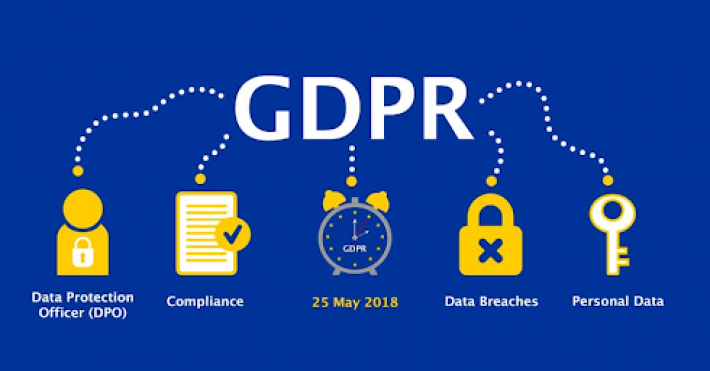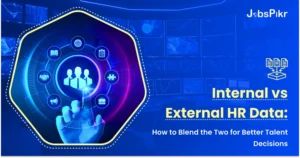GDPR (General Data Protection Regulation) is a new set of data protection regulations enforced by the European Union that came into effect from 25th May 2018. This was created because employees generate a considerable amount of personal data that the Human Resources department has to collect, store, and manage. Even if HR is handling an excel file with employee contact information, it is subject to GDPR and HR systems requirements.
As per a report by IAPP, GDPR compliance was the topmost priority for 58% of companies in Europe. A GDPR-compliant HR software system can reduce the effect of GDPR on the HR team, freeing up their time and enabling better compliance.
Why HR Systems Must Be GDPR-Compliant
HR departments manage a wealth of personal data, making them a critical area for GDPR compliance. From job applications and payroll details to performance appraisals and disciplinary records, HR teams collect, store, and process information that falls under GDPR’s scope. Non-compliance can result in hefty fines, legal challenges, and reputational damage.
GDPR-compliant HR systems ensure that sensitive data is processed lawfully, securely, and transparently. They enable organizations to:
- Minimize the risk of data breaches.
- Respect employees’ rights to access, correct, and delete their data.
- Ensure lawful processing through proper documentation and consent management.
In today’s digital age, where privacy concerns are paramount, a GDPR-compliant HR system demonstrates an organization’s commitment to protecting employee data.
Here are a few steps to maintain GDPR compliant HR systems.
1. Keep HR Data Secure
As per GDPR and HR systems, personal data has to be processed by making sure it is secure. Personal data refers to any detail associated with an identifiable person who can be indirectly or directly identified in particular by reference to the identifier and covers spreadsheets, paper files, and digital documents.

The burden is on you as the data controller to demonstrate. For instance, where the details have been stored, why it has been collected, who has access to it, and the best GDPR and HR systems to store the data.
Another thing that you need to take into account is the data location. The UK Government has stated that it will allow UK data to flow to the EEA during hard Brexit, but the converse isn’t true.
With the help of some GDPR and HR system tools, you can store the human resource information in a secure online HR system. You can take advantage of the advanced security at each level, from role-based access to data encryption to the HR system. When you use this, there is no need to secure paper-based files. Digital or scanned documents can be uploaded to the software system and protected using advanced security.
2. Enhance Data Security
The GDPR and HR systems need personal data to be complete and accurate. So, HR has to put it right when it is not. But it can become unmanageable if employees don’t have access to what data you are holding. The GDPR includes best practice recommendations wherever possible. Companies should provide remote access to a secure self-service system to give employees direct access to their information.

There are tools that make it easier to manage employee self-service with approval workflows and role-based security. Thus, your employees can check their details and remain in complete control of those details. These tools can be configured to fit your requirements. For instance, deciding which details employees can edit, or if the changes should be approved, or who is going to approve them in the GDPR and HR systems.
It is an efficient and secure way to make sure your organization is complying with GDPR requirements. It delivers a service that will make life much easier for the managers, as well as the employees.
3. Appoint a Data Protection Individual
Get in touch with a data processor or a data controller, as they manage the data, to limit the number of people having access to it. Also, the data controller has to train employees to process data and keep everyone updated about GDPR best practices.
- Choose someone with a robust insight into data protection policies and offer ongoing training and education on the topic.
- Get a contract with the offices that cater to the criteria of GDPR and HR systems. According to the stipulation of GDPR, the officers accidentally independently can’t face repercussions for carrying out their responsibilities.
4. Consider the Legality of Processing
The personal data being processed for HR purposes has to be justified on a minimum of one strictly prescribed legal ground. The days of relying on the consent of employees, which is difficult to justify and is unattractive since the right to withdraw consent has to be honored, in the context of an employment relationship, have ended. Rather, alternative legal grounds, such as contractual necessity and the legitimate interests of the organization, are needed.
So, organizations should-
- Audit and allocate certain GDPR-compliant legal grounds to known HR data processing purposes and activities, including the ones that involve special categories.
- Update contractual documents and policy for removing reference to employee consent as the legal basis for data processing in GDPR and HR systems.
- Document all valid legal grounds within the confines of privacy notices, and where required or possible under local laws, a company’s records to process activities.
5. Revisit Contractual Agreements
If any third party is handling your data, revisit the contractual agreements. In case you share employee data with third parties, it is crucial to ascertain that your contracts cater to the requirements of GDPR and HR systems. You should review the list of payroll business partners and HR, and evaluate if they are GDPR compliant.
- Check the old list of how contract and employee data flows across borders.
- Collect data on contacts with whom you are sharing data. This ensures that, when asked, you will be able to provide the details.
Keep in mind, only allowing third parties to access information includes data sharing. In case a consultant abroad can review the data at any point, that is a transfer.
When you are using software from an outside entity for processing personal data, ensure it supports you when it comes to maintaining GDPR compliance.
6. Manifest Data Breach Procedure
Accidents can happen. So, decide and format a procedure as to what to do when a breach occurs. Set down a policy on data breaches to the data protection authority within 72 hours and decide on the mitigation method to use.
- Let them know if the data breaches had been incidental, and it will result in a high risk to the freedom and rights of individuals.
- Make sure that the data controller has the contact details for the right DPA, as he/she is responsible for reporting a breach in the GDPR and HR systems.
When a data breach happens, taking these steps will help your data breach case. Showing that you are making an effort to follow new rules will minimize the repercussions and the chance of the breach having a detrimental effect.
How JobsPikr Can Be Integrated into Your HR Processes
Maintaining GDPR compliance is a critical concern for HR departments, especially when dealing with large volumes of personal data during recruitment processes. JobsPikr can significantly aid HR departments in ensuring GDPR compliance through its advanced data management and processing capabilities. Here are some ways JobsPikr can help:
1. Data Minimization
JobsPikr allows HR departments to scrape only the necessary job data from job postings and resumes, adhering to the GDPR principle of data minimization. This reduces the risk of collecting excessive personal information that isn’t relevant to the hiring process.
2. Automated Data Anonymization
JobsPikr can automatically anonymize personal data within scraped datasets. By removing or obfuscating identifiers, such as names, contact details, and other sensitive information, JobsPikr helps prevent unauthorized access to personal data.
3. Consent Management
JobsPikr can be configured to only scrape job data from sources that explicitly state user consent for data collection and processing. This ensures that the HR department is only handling data that has been legally acquired, aligning with GDPR requirements for lawful processing.
4. Data Accuracy and Quality
JobsPikr ensures the accuracy and quality of the job data collected. By providing up-to-date and accurate information, it helps HR departments can maintain reliable records and avoid issues related to outdated or incorrect data, which is a GDPR requirement.
5. Secure Data Storage and Transfer
JobsPikr employs secure protocols for data storage and transfer, ensuring that all personal data is protected against breaches and unauthorized access. This is crucial for maintaining the integrity and confidentiality of the job data as required by GDPR.
6. Right to Access and Erasure
JobsPikr supports features that facilitate the management of data subjects’ rights, such as the right to access and the right to erasure. HR departments can easily retrieve and delete personal data upon request, ensuring compliance with GDPR’s data subject rights provisions.
7. Audit Trails and Accountability
JobsPikr provides detailed logs and audit trails for all job data collection and processing activities. This transparency helps HR departments demonstrate compliance with GDPR regulations and respond effectively to audits and inquiries from data protection authorities.
8. Data Protection Impact Assessments (DPIA)
JobsPikr assists in conducting DPIAs by providing comprehensive insights into the data processing activities. This helps HR departments identify and mitigate potential risks to personal data, ensuring proactive compliance with GDPR requirements.
9. Regular Compliance Updates
JobsPikr keeps up with the latest changes and updates in GDPR regulations, ensuring that HR departments remain compliant. The platform can adapt to new legal requirements and provide updates to the data processing workflows as needed.
By leveraging these features, JobsPikr helps HR departments streamline their recruitment processes while maintaining strict adherence to GDPR requirements, thus minimizing legal risks and protecting the privacy of job candidates.
Benefits of GDPR and HR Systems Compliance
Complying with GDPR offers HR departments multiple advantages beyond legal protection. Some key benefits include:
- Improved Data Security: GDPR compliance requires robust data security measures, minimizing the risk of breaches and unauthorized access.
- Enhanced Employee Trust: Employees value organizations that prioritize their privacy. Compliance fosters transparency and builds trust within the workforce.
- Operational Efficiency: Implementing GDPR processes often streamlines data management, reducing redundancy and improving workflows.
- Avoidance of Penalties: Non-compliance can lead to fines of up to €20 million or 4% of annual global turnover, whichever is higher. Adhering to GDPR eliminates these financial risks.
- Competitive Advantage: Organizations with GDPR-compliant HR systems gain a reputation as responsible and trustworthy employers, which can attract top talent.
How JobsPikr Enhances GDPR Compliance
JobsPikr offers cutting-edge tools that help HR departments maintain GDPR compliance seamlessly. Here’s how:
- Data Minimization: JobsPikr focuses on collecting only the necessary information from job postings and resumes, aligning with GDPR’s principle of limiting data collection to what is essential.
- Automated Data Anonymization: Sensitive identifiers, such as names and contact details, are anonymized to protect individual privacy and prevent unauthorized access.
- Consent Management: JobsPikr ensures data is sourced from platforms where users have given explicit consent, providing an additional layer of compliance.
- Secure Protocols: The platform employs encryption and secure transfer protocols, ensuring that all data is safeguarded against breaches.
- Compliance Updates: JobsPikr regularly updates its features to stay aligned with evolving GDPR regulations, ensuring your HR department remains compliant at all times.
By integrating JobsPikr into their HR processes, organizations can handle recruitment data with confidence, minimize legal risks, and protect candidate and employee privacy effortlessly.
Conclusion on GDPR and HR Systems
If your organization follows the above-mentioned steps, it can proceed as uninterrupted as you get up to speed with GDPR. Please note that GDPR is here to stay, so take the necessary steps to maintain GDPR compliant HR systems for your organization.
Sign up for JobsPikr today and experience the power of secure, efficient, and compliant recruitment data management.




